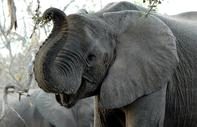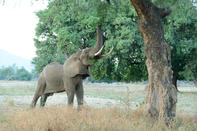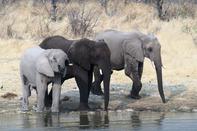Elephant Diet
Elephants make use of a variety of vegetarian substances to meet their enormous dietary requirements. An adult bull consumes 300 kg of food a day (5% of its body weight). They also feed constantly (even through the night) in order to take in enough food. Elephants are hindgut fermenters putting all their food into a single stomach.

The most digestible material is quickly absorbed while the more fibrous contents (accounting for 60% of what was ingested) are excreted. Through-put is rapid (19 hours) and the expulsion of so much undigested material quickly makes room for more to ensure a constant flow of nutrients through the system.
During dry times when food quality is low, this allows the elephant ample opportunity to extract adequate nutrients and prevents time being wasted on the digestion of food that takes lots of energy to break down. A bull elephant may expel up to 155 kg of dung in a day.
This is utilized by dung beetles as well as baboons and birds that pick through the compost for undigested seeds and fruit. Some seeds (like those of marulas, acacias and baobabs see pg…) that have passed through the stomach of the elephant are then more prone to germination due to the chemical and physical scarification of their seed coats which allows better moisture penetration. These seeds then conveniently begin life in a pile of nutrient-rich compost.
Elephants practice geophagia (chew soil) to supplement mineral deficiencies in their diet. They use their toenails to loosen dirt and scoop it into their mouths with their trunks. They may also crowd at sodium-rich water supplies to access the salts they need.
Feeding Routine

Elephants are creatures of habit and although they need to more-or-less feed constantly, they do follow a fairly regular daily routine especially during drier times of the year. Resting usually takes place during the hottest part of the day after a drink or mud-bath at a favored site. The whole herd will take to the shade to rest.
Once the heat diminishes, they will continue feeding into the night and may take a second rest at midnight. Large elephants usually sleep standing up or leaning against a tree or large boulder but smaller animals will lie down on their sides to sleep.
The herd will feed again during the early hours of the morning continuing until they reach the waterhole again during the heat of the day. Elephants can be quite spread out and noisy while feeding but should danger threaten, the whole herd will react immediately freezing to test the air before reassembling and slipping silently away.
The alarm is raised by a trumpet or a scream and the young animals will head to the centre of the herd while the largest ones will position themselves promptly on the side of the source of danger providing a barricade impenetrable to even large predators. Cows on the periphery may rush at lions or other threats to encourage them to depart.
Very young babies always travel under their mothers’ belly between her legs to ensure its safety and in order for the mother to assist it over obstacles and to keep it cool. During normal activities, baby elephant are seldom more than one or two meters from an adult (and the mother is always nearby) and they are constantly touched as reassurance.
Daily Drink

One of the elephants’ major habitat requirements is access to water. Elephants need to drink daily to facilitate the digestion of the many kilograms of coarse material that they eat. They will take in between 100 and 160 litres of water a day, sometimes in one sitting.
They are fussy drinkers and prefer to drink clean water which they access by digging a hole alongside a muddy waterhole and allowing the water to filter into the excavation before drinking it. They are also able to smell underground water and frequently dig holes into which the subterranean water seeps from which they can then drink their fill.
These pools are available to other animals once the elephant is finished drinking, a valuable resource to the ecosystem during dry times. Elephants will travel long distances in pursuit of water at times of shortage and are known to chase off other animals like zebra, sable, warthog and buffalo if limited sources are dwindling.
By Megan Emmett